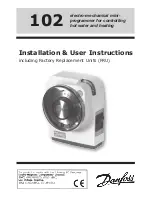
Hazardous voltage!
Risk of electric shock.
→
Disconnect device from the mains before opening.
1.
Loosen screws [2] and remove cover [1].
➥
Terminal compartment [4] is designed for explosion protection Ex e (increased
safety). The flameproof compartment (type of protection Ex d) remains hereby
closed.
2.
Insert cable glands with Ex e approval and of size suitable for connection cables.
➥
The enclosure protection IP… stated on the name plate is only ensured if suita-
ble cable glands are used. Example: Name plate shows enclosure protection
IP 68.
3.
Seal cable entries which are not used with approved plugs suitable for the re-
quired protection type.
4.
Insert the wires into the cable glands.
5.2.2
Cable connection
Table 5:
Terminal cross sections and tightening torques
Tightening torques
Terminal cross sections
Type
2 Nm
(1.5)
1)
2.5 – 6 mm²
(flexible or solid)
Power terminals (U1, V1, W1)
PE connection
1 Nm
0.75 – 1.5 mm²
(flexible or solid)
Control contacts (1 to 50)
with small clamp washers
1)
1.
Remove cable sheathing in a length of 120 – 140 mm.
2.
Strip wires.
→
Controls max. 8 mm, motor 12 mm
3.
For flexible cables: Use end sleeves according to DIN 46228.
4.
Connect cables according to order-related wiring diagram.
Information: Two wires for each connection permitted.
→
When using motor cables with a cross section of 1.5 mm²: Use small clamp
washers for connection to terminals U1, V1, W1 and PE (the small clamp
washers are provided in the electrical connection cover).
19
SAExC 07.1 – SAExC 16.1/SARExC 07.1 – SARExC 16.1
AMExB 01.1
Electrical connection
















































